How can studying local history be meaningful for students? What are the benefits of bringing together national and local archival collections? How can the 1921 Census be accessible and engaging for children?
These were just some of the questions The National Archives’ Education team discussed when planning for the release of the 1921 Census in January 2022. We wanted to give students the chance to gain a rich picture of 1920s life, as well as a greater connection to their local area through looking at a wealth of archival sources.
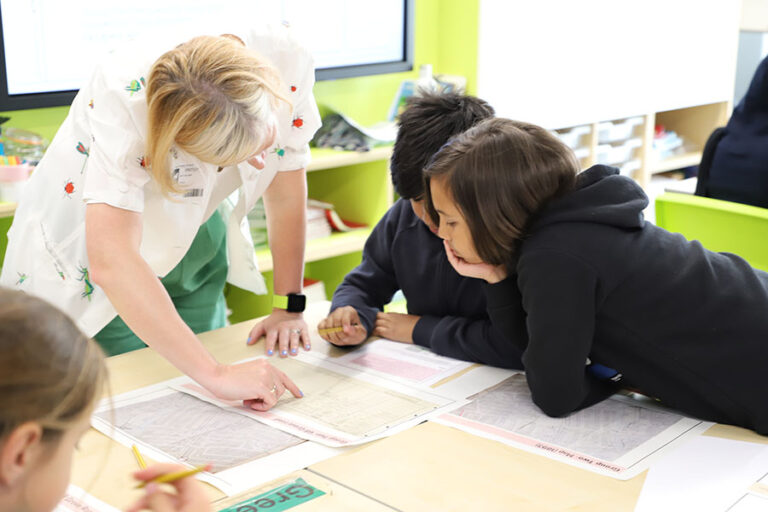
20sStreets was launched with the aim of bringing local history to life for children. The idea was for students to focus on one local street in order to gain a meaningful picture of people’s lives 100 years ago. We partnered with local archives from Tower Hamlets, Lancashire, West Yorkshire and Cornwall (Kresen Kernow). The National Archives’ Education team led online and off site workshops at the schools involved in the project. Students also took part in a creative activity led by local artists: Rudy Loewe in Tower Hamlets, Kate Eggleston-Wirtz in Accrington, Seanna Doonan in Wakefield and Melanie Young in Falmouth.
To start, the four schools involved selected a local street. These ranged from Park Road in Accrington, which today looks much like did in the 1920s, to Thornes Lane in Wakefield, where hardly any older houses remain due to slum clearances. These were just ordinary streets, whose inhabitants’ lives most probably had never been researched before by historians. Inhabitants who included a 15-year-old chocolate dipper, a pianist for silent films, a female school caretaker and a Jewish meat inspector. We could only imagine what fascinating stories we were going to find.
Stories from the 1921 Census
The research process for this project produced many joyful and surprising moments. One such example was the Clark family living at 72 Thornes Lane, Wakefield. David, the father, was recorded as a ‘fish frier’ working ‘at home’ and two of his daughters – Ivy, aged 17, and Laura, aged 20 – were ‘fish frier assistants’. This conjured many images of a busy and probably fairly fragrant home!
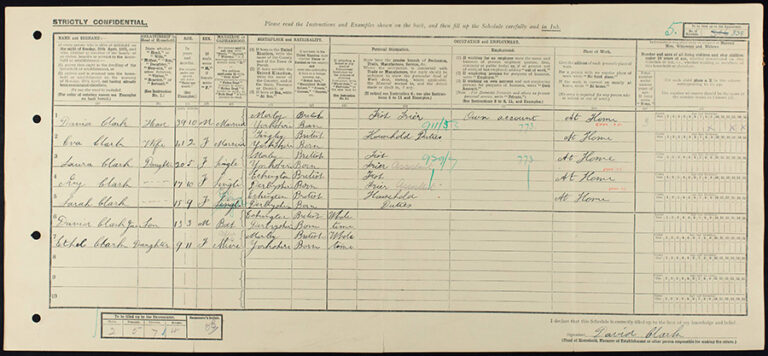
The census gave glimpses into intriguing figures. The 1921 Census lists people’s employers, providing opportunities for further research. Living at 134 Grove Road in Mile End was William Short, listed as a ‘surgery attendant’ working for Dr M A Wajid, 38 Green Street. This sparked curiosity, but a search for the surname ‘Wajid’ proved fruitless. In the end he was located in the census through searching for the address, which revealed more about him. Born in Bangalore, India, Muhammed Abdul Wajid was listed as an ‘employer’ working ‘at home’, presumably a medical practice. We wanted to find out more about him.
Sanjida Alam, heritage officer at Tower Hamlets Library and Archives, shared our enthusiasm. She uncovered many more documents linked to Mohammed Wajid, for instance the 1920 trade directory where he was listed at 38, but also 241 Green Street. When we looked this address up there were seven people listed as working for Dr Wajid. One was Emmanuel Payne, a ‘medical practitioner’ born in Guyana, formerly British Guiana. Six of the people listed were from Edinburgh. Investigating further, Sanjida found that Dr Wajid had studied to become a doctor at Edinburgh University, his graduation recorded by The Scotsman newspaper in 1909. We still have many questions about Mohammed Wajid that our research can’t answer. When did he arrive in Britain? Did he meet these medics at university? How did he come to settle in East London?
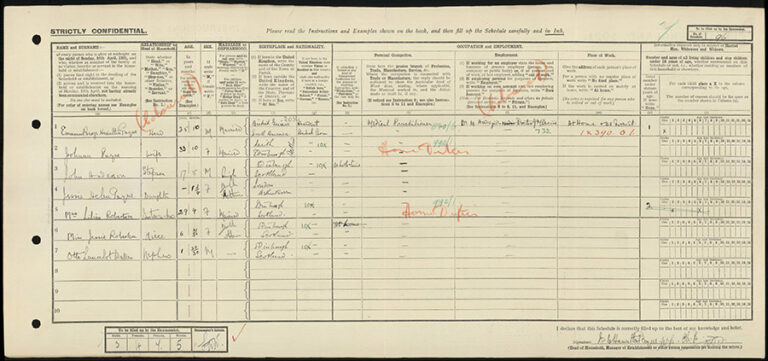
One of the teachers involved said ‘it was fantastic to see the children ask so many questions.’ The practice of asking questions, so critical to historical research, was a key element of the project. Questions posed by children after investigating the census records were returned to later in the workshops. Some were answered but many, as with all historical research, remained mysteries. In their evaluation one child expressed that they did not like ‘not finding the answer’. Indeed this project gave students an insight into the joys, as well as the inevitable frustrations, of historical research.
We gave the census record to students as a double-sided document, with the transcript on the back. We encouraged children to look at the handwritten side first and to try to decipher as much as they could. The handwriting on the 1921 Census provides a closer connection with the household, as it was completed by a member of the family.
Local history detective work
Local archive collections gave students a much richer picture of people’s lives, by providing further documents that they could piece together as clues. For instance, the census return for Allan Hargreaves, living at 68 Park Road, Accrington, raised questions when his birthplace was listed as ‘at sea’. Using the ship’s passenger list, students learned that he was born in 1908 on board the Lusitania, famously sunk by a German U-boat in 1915. Housed in Lancashire Archives’ collection is a booklet about the Lusitania, giving insight into this family’s voyage. Also in their collection are architectural plans for houses on Park Road, providing an incredible glimpse into the home that Allan lived in.
There were thrilling moments of connection between the census and local collections, thanks to the students’ diligent research. One example was the discovery by the West Yorkshire Archives team of an architectural plan of the Jolly Sailor Inn on Thornes Lane from 1921 – the precise year! This enabled students who had examined the census record for the pub to imagine ‘walking’ through the pub, complete with ‘snug room’ and ‘smoke room’. The Kresen Kernow team even managed to find the gravestone for William Swadling in an overgrown cemetery, the husband of Violent Swadling listed on the census as ‘widowed.’ Just a 10-minute walk from King Charles Church of England School, this provided an opportunity for a greater connection to the local area.
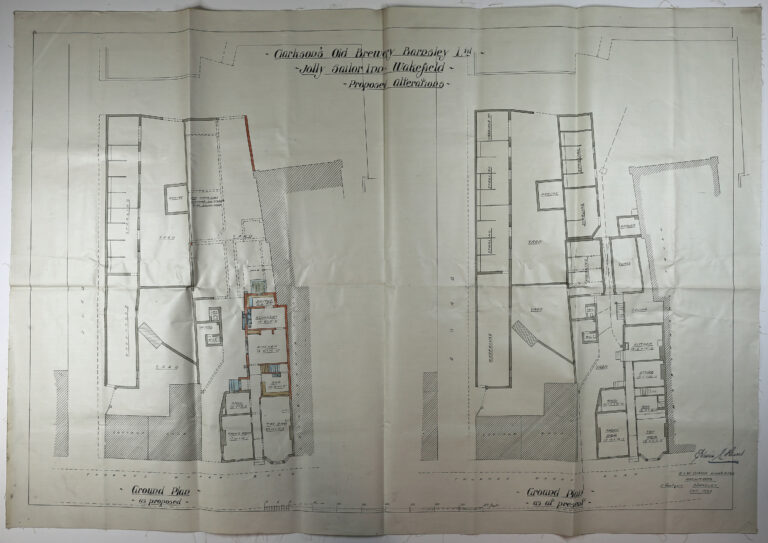
Creative outcomes
The project’s creative elements allowed students to move from historical investigation and inference, to imagining aspects of 1920s life not evident in the documents. One of the most common queries from children was what people looked like. Students from Olga School in Tower Hamlets drew portraits of their families, often holding objects related to jobs, faces expressing an emotion they might have felt. The stop-motion animation created by students at King Charles Church of England School brought to life characters from the census record, even a dramatic fight between a donkey and a goat … a long story! In Methodist Junior School in Wakefield students decorated wooden, house-shaped clocks inspired by homes and buildings. A vintage door collaged with images of documents by students at Hyndburn Primary School will sit in the school’s playground. It will be used as a learning resource where students can post letters to people in the past. One teacher commented that the artist was able to ‘bring the stories to life’and extend students’ learning.
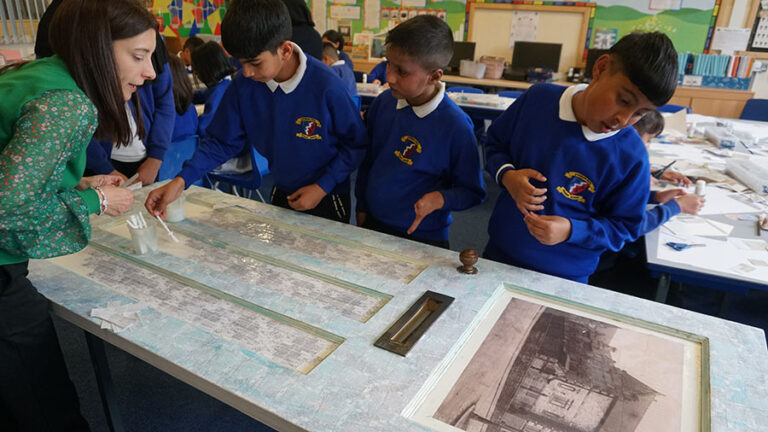
Outcomes
This project encouraged students to actively investigate the 1920s, and gain a deeper understanding of the era and address historical misconceptions. For instance, the role of women emerged as a key theme. Students were encouraged to reflect on who might have been most commonly listed on the census as undertaking ‘home duties’ and why domestic activities would have taken much longer than today. As David Tilsey from Lancashire Archives said, history is so huge ‘it is difficult for adults, let alone children to get their heads around it as a concept’ but ‘if you bring it down to the local and make the point that this place has a history too, then the kids can feel far more a part of that’.
We were struck by the compassion and connection students demonstrated with the people they studied. Frequently they mentioned individuals by name in evaluations; one student said they liked ‘finding out about Robert and Henry’. Often children reflected on similarities with their own lives; for instance, one student said they could imagine the house might have been quite busy and loud because they also lived with a one-year old sibling! One group in Falmouth expressed real sympathy for Robert Kinsman of 2 Lister Street when they discovered from burial records that his mother, who lived with him, had died just a few weeks before the census was completed.
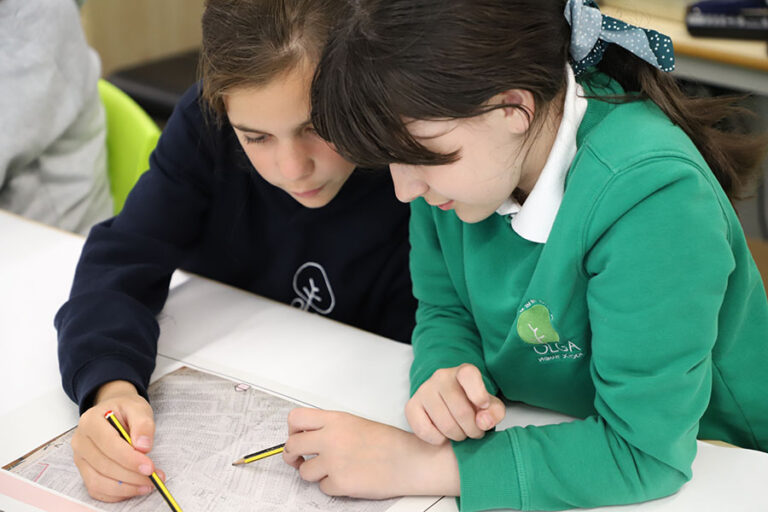
The project showed that studying local history can strengthen children’s links to their local area and sense of identity. For some students this could be through direct links with the people in the 1921 Census. Indeed a student in Falmouth, inspired by the workshops, found a handwritten family tree relating them to one of the people they learnt about! Or it may be a closer connection to place. As one teacher noted, this could be really powerful for students whose families had settled in the area more recently. A student at Hyndburn Park Primary school said local history ‘brings you closer to the people who lived here before and makes you appreciate what’s around you.’
The National Archives’ Education service will continue to work with schools involved in 20sStreets and plans are underway to establish a collaborative local history regional programme.
Project resources
- We’ve created a Key Stage 2 online education resource – ‘What can archives reveal about people’s lives in the 1920s?’ It includes case studies used in this project, with a range of different types of historical documents
- Watch this video created by Postcode Films about the project
- Watch this animation created by year 6 students at King Charles Church of England School
The education team want to say a huge thank you to: Sanjida Alam and Richard Wiltshire at Tower Hamlets Library and Archive, Anna Carter and Dominque Triggs at West Yorkshire Archive Service, David Tilsey and Lee Sanderson at Lancashire Archives, and Chloe Philips at Kresen Kernow. Thank you to all of the teachers who took part so enthusiastically from Olga Primary School, Hyndburn Park Primary School, Methodist Infant School and King Charles Church of England School. An enormous thank you to Jaime Taylor at Postcode Film. Lastly a big thank you to the artists involved in the project: Rudy Loewe, Seanna Doonan, Melanie Young and Kate Eggleston-Wirtz.
Lovely project. Children’s animation is super. I should think the Edinburgh University alumni office, which produces a magazine sent out regularly to graduates would be interested in further research about Dr Wajid